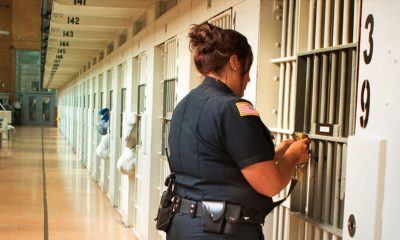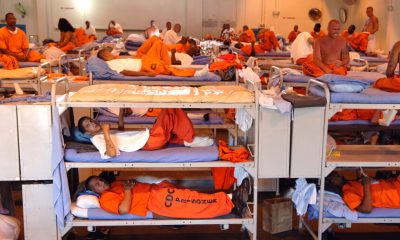Politics
Use of Video Visits for Inmates Grows, Along with Concerns

In this photo taken on Tuesday, May 5, 2015, inmate Jesse Cole is shown on a television screen as his son William, 4, center, reaches to touch the screen while his mother, Edna, holds 8-month-old Jesse James, during a video visitation with at the Fort Bend County Jail, in Richmond, Texas. Prisoners rights advocates are worried that the growing use in the U.S. of video technology to facilitate visits between inmates and their family and friends at county jails and prisons is part of a trend to eliminate the more traditional in-person visit. But officials who run these facilities say video visitation has been a boon to their efforts to improve security and increase visiting hours. (AP Photo/David J. Phillip)
JUAN A. LOZANO, Associated Press
RICHMOND, Texas (AP) — Four-year-old William Cole saw his father’s face and reached out to touch it during a jail visit. But he could only feel a video screen.
The facility in Fort Bend County, southwest of Houston, is among a growing number of jails and prison systems across the U.S. in which video visitation has replaced the more familiar in-person visits, where people are in the same room but separated by thick glass.
William’s mother found it jarring to have to communicate with her husband through pixels rather than face to face. In video visitation, inmates and their visitors are not in the same room but see each other on computer or television screens.
“This was a very big shock for me,” said Edna Cole, 24, as her son talked with his dad from one of 34 screens in the jail’s visitation area. “I’m used to actually being able to see them in person, and here I can’t do that.”
Officials who run the facilities say video visits have improved security and increased visitation hours. However, prisoners’ rights advocates worry the trend is to eliminate free in-person visits for a system they say is full of technical glitches and could eventually require families to pay a fee.
Because of the backlash, the Texas House recently approved a bill guaranteeing a minimum of two in-person visits per week at county jails, but it’s unclear if the measure will pass the Senate.
According to the Prison Policy Initiative, a Massachusetts-based nonprofit group, about 545 correctional facilities (mostly county jails) in 43 states and the District of Columbia use video visitation. While video visitation was first used in the 1990s, much of its growth has taken place the last two to three years.
A report in January by the nonprofit found that 74 percent of county jails banned in-person visits when they started using video visitation. In Texas, of the 23 counties using video visitation, 13 have eliminated in-person visits.
The group also found that at least one of the major companies in video visitation, Dallas-based Securus Technologies, has included language in its contracts requiring the elimination of in-person visits.
Bernadette Rabuy, with Prison Policy Initiative, said video visitation can be beneficial as it allows inmates in facilities far from loved ones to have contact. While it is currently not a big money maker for companies, Rabuy is concerned video visitation will become a large revenue source as people are pushed to use it from home. While video visitation is usually free at a jail, fees to use it from home can be up to $1.50 per minute.
In Fort Bend County, video visitation — in use since 2009— improved efficiency and security as inmates no longer had to be moved to visiting areas and it ended the passing of contraband between visitors and inmates, said Sheriff’s Office Lt. Daniel Quam. The change also freed up personnel and extended visitation hours, he said.
Quam said his agency has focused on providing the best service possible, including building a room for use by families and offering 30 minute visits when state law only requires 20 minutes.
The Arkansas Department of Correction, which in April approved a video visitation contract, will not eliminate in-person visits, said spokeswoman Cathy Frye. In the U.S., nearly 30 state prison systems use video visitation.
A December report by the National Institute of Corrections recommended using both in-person and video visitation.
Sue Gregory, 50, who used video visitation last year when her husband was held at a detention center in Camp Verde, Arizona, said video visits eliminate human interaction that’s beneficial for inmates.
“If the only way you have to visit is through a TV monitor, that is not a real visit,” she said.
Travis County, which includes the state capital of Austin, eliminated in-person visits in 2013 but is discussing whether to bring them back. Two lawsuits were filed this year in Denton County, Texas, after in-person visits were eliminated.
Sheriff Dan Staton considered ending in-person visits in the Oregon county that includes Portland after signing a contract with Securus Technologies that called for doing so. But after listening to community feedback, Staton decided to have both video visitation and in-person visits in Multnomah County.
In Arkansas, Securus didn’t push for the elimination of in-person visits in its contract with the state but offered a higher commission from revenue if the state urged inmates to use the service, Frye said
Josh Gravens, with Texas CURE (Citizens United for Rehabilitation of Errants), a prisoners’ rights group, said a large group mobilized last year in Dallas County after officials considered approving a video visitation contract with Securus that would have eliminated in-person visits. That contract was rejected, and another that included both forms of visitation was later approved.
Earlier this month, Securus announced it would no longer include in its contracts restrictions related to in-person visits. A spokesman for Securus did not respond to numerous phone calls and emails seeking comment.
Philip Hilder, a Houston criminal defense attorney and former federal prosecutor, said while the Supreme Court has found that jail and prison visits can be restricted, the rise of video visitation could mean it’s time to revisit the issue.
“There is room for technology to play a role here,” Hilder said. “But to say that technology should supplant personal visitation would be a grave error. I think it would create a lot more problems because people will feel much more disconnected by not having that human element.”
___
Follow Juan A. Lozano on Twitter at www.twitter.com/juanlozano70
Copyright 2015 The Associated Press. All rights reserved. This material may not be published, broadcast, rewritten or redistributed.
Activism
Oakland Post: Week of April 24 – 30, 2024
The printed Weekly Edition of the Oakland Post: Week of April 24 – 30, 2024

To enlarge your view of this issue, use the slider, magnifying glass icon or full page icon in the lower right corner of the browser window. ![]()
Bay Area
MAYOR BREED ANNOUNCES $53 MILLION FEDERAL GRANT FOR SAN FRANCISCO’S HOMELESS PROGRAMS
San Francisco, CA – Mayor London N. Breed today announced that the U.S. Department of Housing and Urban Development (HUD) has awarded the city a $53.7 million grant to support efforts to renew and expand critical services and housing for people experiencing homelessness in San Francisco.

FOR IMMEDIATE RELEASE:
Wednesday, January 31, 2024
Contact: Mayor’s Office of Communications, mayorspressoffice@sfgov.org
***PRESS RELEASE***
MAYOR BREED ANNOUNCES $53 MILLION FEDERAL GRANT FOR SAN FRANCISCO’S HOMELESS PROGRAMS
HUD’s Continuum of Care grant will support the City’s range of critical services and programs, including permanent supportive housing, rapid re-housing, and improved access to housing for survivors of domestic violence
San Francisco, CA – Mayor London N. Breed today announced that the U.S. Department of Housing and Urban Development (HUD) has awarded the city a $53.7 million grant to support efforts to renew and expand critical services and housing for people experiencing homelessness in San Francisco.
HUD’s Continuum of Care (CoC) program is designed to support local programs with the goal of ending homelessness for individuals, families, and Transitional Age Youth.
This funding supports the city’s ongoing efforts that have helped more than 15,000 people exit homelessness since 2018 through City programs including direct housing placements and relocation assistance. During that time San Francisco has also increased housing slots by 50%. San Francisco has the most permanent supportive housing of any county in the Bay Area, and the second most slots per capita than any city in the country.
“In San Francisco, we have worked aggressively to increase housing, shelter, and services for people experiencing homelessness, and we are building on these efforts every day,” said Mayor London Breed. “Every day our encampment outreach workers are going out to bring people indoors and our City workers are connecting people to housing and shelter. This support from the federal government is critical and will allow us to serve people in need and address encampments in our neighborhoods.”
The funding towards supporting the renewal projects in San Francisco include financial support for a mix of permanent supportive housing, rapid re-housing, and transitional housing projects. In addition, the CoC award will support Coordinated Entry projects to centralize the City’s various efforts to address homelessness. This includes $2.1 million in funding for the Coordinated Entry system to improve access to housing for youth and survivors of domestic violence.
“This is a good day for San Francisco,” said Shireen McSpadden, executive director of the Department of Homelessness and Supportive Housing. “HUD’s Continuum of Care funding provides vital resources to a diversity of programs and projects that have helped people to stabilize in our community. This funding is a testament to our work and the work of our nonprofit partners.”
The 2024 Continuum of Care Renewal Awards Include:
- $42.2 million for 29 renewal PSH projects that serve chronically homeless, veterans, and youth
- $318,000 for one new PSH project, which will provide 98 affordable homes for low-income seniors in the Richmond District
- $445,00 for one Transitional Housing (TH) project serving youth
- $6.4 million dedicated to four Rapid Rehousing (RRH) projects that serve families, youth, and survivors of domestic violence
- $750,00 for two Homeless Management Information System (HMIS) projects
- $2.1 million for three Coordinated Entry projects that serve families, youth, chronically homeless, and survivors of domestic violence
In addition, the 2023 CoC Planning Grant, now increased to $1,500,000 from $1,250,000, was also approved. Planning grants are submitted non-competitively and may be used to carry out the duties of operating a CoC, such as system evaluation and planning, monitoring, project and system performance improvement, providing trainings, partner collaborations, and conducting the PIT Count.
“We are very appreciative of HUD’s support in fulfilling our funding request for these critically important projects for San Francisco that help so many people trying to exit homelessness,” said Del Seymour, co-chair of the Local Homeless Coordinating Board. “This funding will make a real difference to people seeking services and support in their journey out of homelessness.”
In comparison to last year’s competition, this represents a $770,000 increase in funding, due to a new PSH project that was funded, an increase in some unit type Fair Market Rents (FMRs) and the larger CoC Planning Grant. In a year where more projects had to compete nationally against other communities, this represents a significant increase.
Nationally, HUD awarded nearly $3.16 billion for over 7,000 local homeless housing and service programs including new projects and renewals across the United States.
Activism
Oakland Post: Week of April 17 – 23, 2024
The printed Weekly Edition of the Oakland Post: Week of April 17 – 23, 2024

To enlarge your view of this issue, use the slider, magnifying glass icon or full page icon in the lower right corner of the browser window. ![]()
-

 Activism4 weeks ago
Activism4 weeks agoOakland Post: Week of March 27 – April 2, 2024
-

 #NNPA BlackPress4 weeks ago
#NNPA BlackPress4 weeks agoBeloved Actor and Activist Louis Cameron Gossett Jr. Dies at 87
-

 Community1 week ago
Community1 week agoFinancial Assistance Bill for Descendants of Enslaved Persons to Help Them Purchase, Own, or Maintain a Home
-

 Activism3 weeks ago
Activism3 weeks agoOakland Post: Week of April 3 – 6, 2024
-

 Business1 week ago
Business1 week agoV.P. Kamala Harris: Americans With Criminal Records Will Soon Be Eligible for SBA Loans
-

 Activism2 weeks ago
Activism2 weeks agoOakland Post: Week of April 10 – 16, 2024
-

 Community1 week ago
Community1 week agoAG Bonta Says Oakland School Leaders Should Comply with State Laws to Avoid ‘Disparate Harm’ When Closing or Merging Schools
-

 Community6 days ago
Community6 days agoOakland WNBA Player to be Inducted Into Hall of Fame
























































